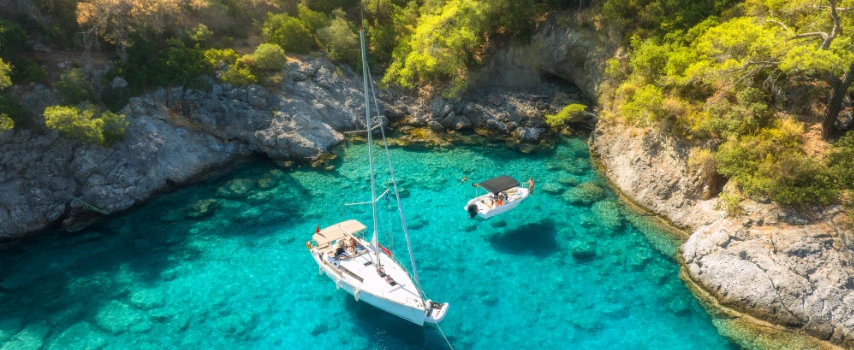7 details you need to buy our travel insurance
This travel insurance checklist can help you gather the important details you need to know about your trip before you can adequately protect it.

Source: Getty
If you’re planning your first trip in a while, you may be wondering, “What details do I need to have when buying travel insurance?” Well, there are several details you should know and have on-hand when you when you buy your travel insurance policy to help you choose the right level of cover for your trip and planned activities.
The details you need to have on hand may change depending on the travel insurance provider you’ve chosen. In this article, you’ll learn more about the details you need to have when buying travel insurance from us.
“Before purchasing a travel insurance policy, it’s useful to ask yourself some key questions about your travel plans, what you would like to do on your trip, and also your personal circumstances. This may help determine which cover options suit your journey,” says Will Ashcroft, Managing Director of Cover-More Travel Insurance in New Zealand.
Not exactly sure what those important questions and details are? Keep reading to learn more about what is handy to have on hand.
Here’s a checklist of the seven details you need to get a quote for our travel insurance
- Your destination(s)
- Your travel dates
- Whether your trip is for business or pleasure
- Who you’re travelling with
- What you’ll be doing on your trip
- Which valuables you’ll be taking
- Your pre-existing medical conditions

Source: Getty
It's smart to have these details on hand when getting your Cover-More travel insurance quote
#1: Where are you travelling to?
A list of all the locations you’ll be visiting is something that is important when buying travel insurance.
Why? Because the places you’re planning to visit may affect how much your travel insurance will cost … and whether you can take out insurance at all.
When you generate a quote, the insurance premium you’re presented with may take into consideration your chosen destinations’ distance from New Zealand, the likelihood of needing to make a claim while at the listed locations (because some destinations are considered riskier than others), the cost of medical services there, and more. For example, protecting a trip to America will generally cost more than travel insurance for a holiday in Australia because it's further away and has higher medical costs.
While our Cover-More travel insurance generally provides cover for most destinations around the world, there are some instances where we cannot provide cover. If a destination has a ‘Do not travel’ warning on safetravel.govt.au, our policies will not cover claims related to the reason this destination has a ‘Do not travel’ warning and our ability to provide you with emergency assistance is extremely limited, so it’s good to check your destination’s advice level before booking your trip.
Good to know: The New Zealand Government can apply a “Do not travel” warning to a destination for several reasons, but common ones include sanctions, environmental or natural disasters, civil unrest, war, or health threats.
When purchasing, remember to enter all the destination(s) you plan to visit.
Note: If 20% or more of any journey will be spent in the Americas or Antarctica, you must nominate the area including these countries as the main destination.
#2: When are you travelling?
It’s important to decide when you will start and end your trip before you purchase our travel insurance, to ensure you get the correct cover for your entire trip.
When submitting your travel dates, it’s best to include the date you leave home as your start date and the date you arrive back home as your end date for optimal protection.
Tip: When entering your trip end date, remember to enter the date you will arrive home in New Zealand based on NZST, taking into consideration any time differences/zones and travel times.
Did you know we also offer a Cover-More Annual Multi-Trip travel insurance option? This travel insurance plan includes cover for an unlimited number of domestic and international trips over a 12-month period within your chosen destination(s) up to the maximum trip length you choose. If you’re a frequent traveller – or if you know you have several trips planned for the year ahead – this policy type may be a good option for you.

Source: Getty
#3: Are you going on a holiday or a business trip?
Your travel needs may vary depending on the purpose of your trip, so a clear understanding of your trip type is one of the details you need to have when buying our travel insurance.
At Cover-More, our plans – Basic, Comprehensive, and Comprehensive+ – are designed for leisure travellers going on holiday. So, if you’re planning a domestic or international getaway, these plans are likely suitable for your upcoming adventure.
Going on a business trip? While some of the benefits offered by our plans may be suitable for people going on work trips (our Comprehensive+ Plan even includes a Business Pack for business-related cover), we also offer a specific Business travel insurance plan. This plan can cover multiple business trips within one year, so if you’re frequently travelling for work, please give us a call to discuss if this plan is suitable for you.
#4: Are you travelling with friends or family?
Is your upcoming trip a solo adventure, or a holiday you’ll be enjoying in the company of family or friends? This is one of the details you need to have confirmed when buying our travel insurance, to ensure you get an accurate quote – and coverage for your nearest and dearest on the same policy if you wish.
Want to include more than one person on your policy? Depending on your travel companions and their personal circumstances, you may need to consider a higher level of cover than you originally planned. For example, if certain members of your travel group have existing medical conditions, and you want cover for those conditions, you will need to declare each individual’s conditions so we can complete an assessment of them and determine if we can provide cover for the conditions when purchasing the travel insurance policy.
#5: What will you be doing on your holiday?
No two holidays are alike, so before buying traveling insurance, it’s helpful to know what kind of activities you’ll be indulging in while you’re away.
For example, will you be riding a motorcycle or moped, taking part in snow sports, or trying adventure activities such as skydiving during your travels? Consider what activities will make up your holiday and how long you’ll be experiencing each activity. Yes, a clear plan for your holiday is something that can help ensure you have appropriate cover under the travel insurance policy you purchase.
There are certain activities – mainly those that come with an additional element of risk – that a base travel insurance plan may not provide cover for. You can tailor your cover by including optional coverage variations in your policy for coverage while taking part in certain activities.
At Cover-More, our travel insurance plans provide you with options to vary your cover (for an additional premium).
These include:
- Cruise Cover: For your sea or ocean cruise holiday of two days or more.
- Snow Sports or Snow Sports+ cover: For if you will be snowboarding, snowmobiling, cross-country skiing, and more.
- Adventure Activities or Adventure Activities+ cover: For if you will be participating in activities not automatically included in our base plans, such as bouldering, water skiing , scuba diving, and more.
- Motorcycle/Moped Riding+ cover: For if you plan on riding or being a passenger on a motorbike or moped with an engine capacity over 250cc while on your trip.

Source: Getty
#6: Are you taking valuables on your trip?
It’s normal to take valuables such as your smartphone or tablet on holiday these days. But are you taking any additional valuables, such as DSLR cameras, laptops, designer clothing or expensive jewellery with you too?
While our Cover-More travel insurance plans offer some cover for valuables, there are limits around what (and how much) we potentially may be able to provide cover for. If you’re taking multiple valuables with you on your travels, it may be worth considering increasing the luggage item limit on any items you’d like extra cover for.
If you are considering increasing cover for your high-value items, keep in mind that the standard terms and conditions outlined in the Policy Wording will apply to your luggage items. Under our policy, cover for luggage items is subject to item limits and sub-limits, excess (if chosen), reasonable depreciation, the original purchase price of the item and other factors. Please ensure you read the Policy Wording carefully when choosing what level of cover is right for you and your items.
Not sure if you need to increase your luggage item limits? Read the Policy Wording to understand the benefit coverage and item limits and sub-limits on your chosen plan to understand if the value of the higher-ticket items you intend to pack may be covered in full. If not, you have the option of increasing the limit of certain valuables when getting a quote.
Tip: If you need to make a luggage claim, don’t forget to locate the item’s receipt or valuation to help support your claim submission.
#7: Do you have any existing medical conditions?
Please carefully consider your existing medical conditions when purchasing travel insurance. A full list of your existing medical conditions is something you’ll need if you want us to assess them for cover when you get a Cover-More travel insurance quote. (This goes for anyone else included on your policy too.)
Yes, there are several medical conditions we do automatically provide cover for; however, you – and all travellers on the policy – must meet all the conditions and all the conditions must be on this list. You can view the entire list of automatically included conditions here.
If you have existing medical conditions not included on the “automatically covered” list, your conditions don’t meet the conditions outlined on the list and/or not all your conditions are on this list, if you want us to assess your conditions for cover under your policy, you must declare all your existing medical conditions via our online medical assessment tool during the quote process. If you don’t, you may not have adequate cover – and related claims may be denied.
Once you declare your condition(s) via the online assessment tool, we will assess your conditions to determine if they can be covered under your policy. If we accept them, you’ll then be able to include the additional cover in your policy. Some conditions may require an additional premium and others may not. For more information on this, visit our existing medical conditions page.
Have you gathered the details you need to know to buy our travel insurance?
Once you’ve finalised and gathered as many details as you can, such as where you are travelling to, your travel dates, whether the trip is for business or pleasure, who you’re travelling with, which activities you’ll be doing on your trip, which valuables you’ll be taking with you, and any pre-existing medical conditions you have, it’s time to insure your trip by purchasing your travel insurance. Once that’s done, you can focus on what matters most – enjoying your getaway.